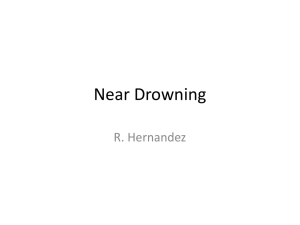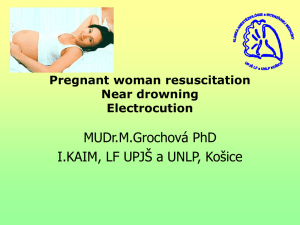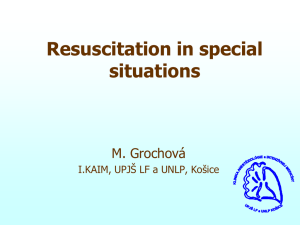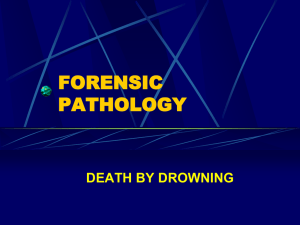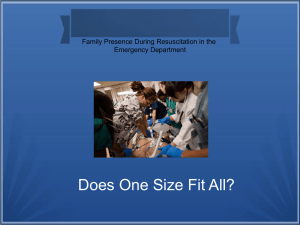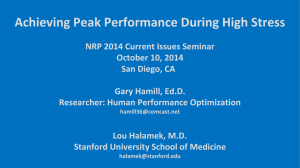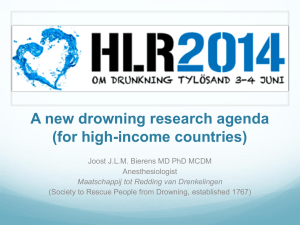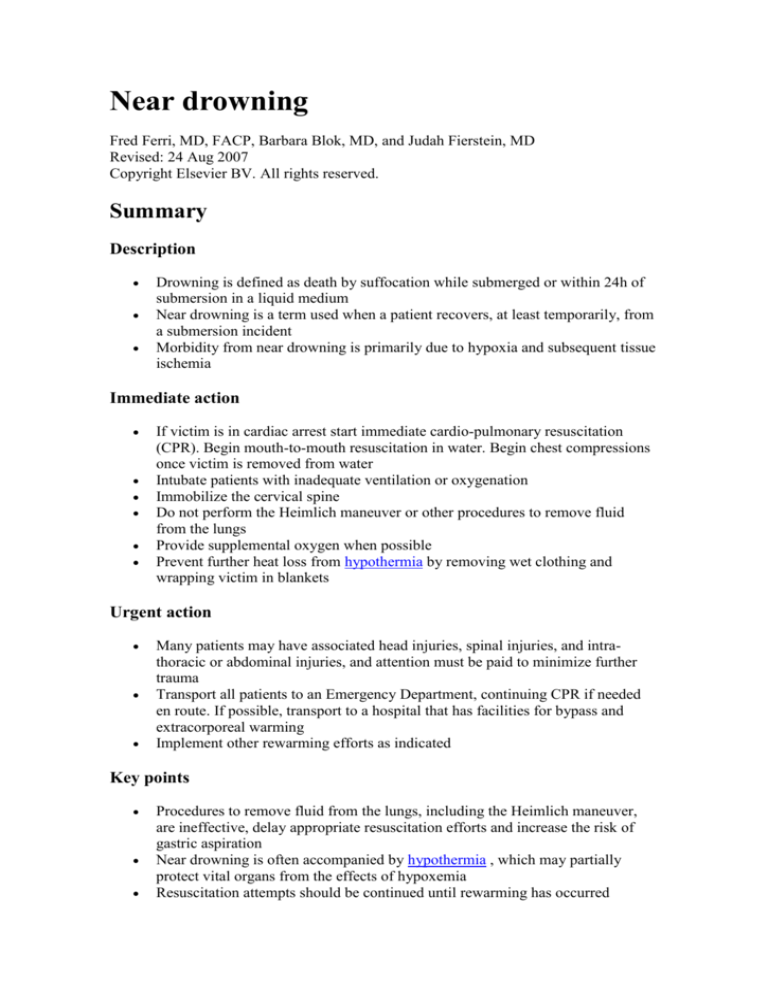
Near drowning
Fred Ferri, MD, FACP, Barbara Blok, MD, and Judah Fierstein, MD
Revised: 24 Aug 2007
Copyright Elsevier BV. All rights reserved.
Summary
Description
Drowning is defined as death by suffocation while submerged or within 24h of
submersion in a liquid medium
Near drowning is a term used when a patient recovers, at least temporarily, from
a submersion incident
Morbidity from near drowning is primarily due to hypoxia and subsequent tissue
ischemia
Immediate action
If victim is in cardiac arrest start immediate cardio-pulmonary resuscitation
(CPR). Begin mouth-to-mouth resuscitation in water. Begin chest compressions
once victim is removed from water
Intubate patients with inadequate ventilation or oxygenation
Immobilize the cervical spine
Do not perform the Heimlich maneuver or other procedures to remove fluid
from the lungs
Provide supplemental oxygen when possible
Prevent further heat loss from hypothermia by removing wet clothing and
wrapping victim in blankets
Urgent action
Many patients may have associated head injuries, spinal injuries, and intrathoracic or abdominal injuries, and attention must be paid to minimize further
trauma
Transport all patients to an Emergency Department, continuing CPR if needed
en route. If possible, transport to a hospital that has facilities for bypass and
extracorporeal warming
Implement other rewarming efforts as indicated
Key points
Procedures to remove fluid from the lungs, including the Heimlich maneuver,
are ineffective, delay appropriate resuscitation efforts and increase the risk of
gastric aspiration
Near drowning is often accompanied by hypothermia , which may partially
protect vital organs from the effects of hypoxemia
Resuscitation attempts should be continued until rewarming has occurred
The prognosis depends on how long the patient has been immersed in the water,
how much fluid has been aspirated, and the temperature of the water
Background
Cardinal features
In the majority of cases, victims aspirate the water in which they have been
submerged (majority are freshwater). This is commonly called 'wet drowning'
In about 15% of cases, severe laryngospasm prevents aspiration but hypoxemia
still occurs. This is called 'dry drowning'
Hypoxia occurs from aspiration, laryngospasm or apnea
Secondary CNS injury and cardiac dysrhythmia or cardiac arrest occur as a
result of hypoxia
The distinction between near drowning in sea water or fresh water is less
clinically important than previously thought
Aspiration pneumonia, acute respiratory distress syndrome , disseminated
intravascular coagulation and hemolysis may complicate near-drowning injuries
Victims seldom aspirate enough water to cause a change in their serum
electrolytes
Causes
Common causes
Submersion in water.
Contributory or predisposing factors
Drug or alcohol intoxication in either the victim or a supervising person
Other intoxicants: either taken by the victim or the supervisor
Hypothermia after prolonged immersion (such as after boating accidents)
Trauma, especially cervical spine injuries after diving accidents
Overestimation of swimming abilities
Deliberate hyperventilation in attempt to improve underwater swimming
duration
Cold water shock - gasp reflex, hyperventilation, panic and ineffective
swimming upon entering cold water
Seizure disorders
Child neglect or abuse may be important especially in domestic bathing
incidents
Dysbaric event in scuba divers
Hypoglycemia
Cerebrovascular accident
Epidemiology
Incidence and prevalence
Incidence
Drowning: 6000-8000 deaths/year in the US
Near drowning: 7000 cases/year in US
Demographics
Age
Trimodal distribution with peaks in toddlers and young children, preschool ages
and in late adolescents and young adults, and elderly people with disabilities
and/or dementia
Toddler near drownings in domestic swimming or paddling pools tend to occur
most frequently around meal preparation times
Adult near drownings tend to occur in late afternoons and evenings
Gender
Both sexes equally at risk at all ages except for late adolescence/early adulthood when
males are at far greater risk.
Race
African-American children have an increased frequency of submersion incidents than
Caucasian children (4.5 per 100,000 versus 2.6 per 100,000).
Geography
In the warmer areas of the US, Australia, and South Africa, 70-90% of near
drowning events occur in family swimming pools
In colder climates in the US (Minnesota and Washington) and around the world
(Canada, northern Europe) most near drowning events occur in natural bodies of
fresh water
Socioeconomic status
Near drowning is more common in lower socio-economic groups.
Codes
ICD-9 code
E910 Accidental Drowning and Submersion
E994.1 Drowning and nonfatal submersion
E832 Other accidental submersion or drowning in water transport accident
E910.8 Other accidental drowning or submersion
Diagnosis
Clinical presentation
Symptoms
Shortness of breath
Cough
Confusion, disorientation and/or inappropriate elation
Nausea and vomiting
Abdominal distention
Symptoms of other injuries (from e.g. intra-abdominal or thoracic trauma, spinal
injuries)
Symptoms of hypothermia
Signs
Unconscious or impaired consciousness
Cardiopulmonary arrest
Persistent cough
Tachypnea
Respiratory distress: rales, rhonchi, wheezing, pulmonary edema
Bradycardia or tachycardia
Hypothermia
Unconscious or impaired consciousness
Hypotension
Hyperpyrexia
Associated disorders
Depending on the mechanism of submersion there may be other traumatic injuries to the
spine, brain, intrathoracic or abdominal organs and the limbs.
Differential diagnosis
Hypothermia
Head injury
Workup
Diagnostic decision
The diagnosis is initially made based entirely on clinical grounds
Many near drowning events are not witnessed
Rapid assessment and initiation of any necessary resuscitation should be
undertaken without delay
The main clinical decision on appraisal involves an assessment for signs or
symptoms of significant submersion and the presence of predisposing factors
Guidelines
The American Heart Association has produced:
Idris AH, Berg RA, Bierens J, et al; American Heart Association. Recommended
guidelines for uniform reporting of data from drowning: the "Utstein style" .
Circulation 2003;108:2565-74
Don't miss!
Hypothermia may protect against hypoxic brain injury
Rarely, complete neurologic recovery may be possible even in cases of severe
hypothermia, absent peripheral pulses, profound bradycardia or asystole, fixed
and dilated pupils, and no signs of primitive reflexes
A diagnosis of death should not be made without undertaking vigorous
resuscitation and transporting the patient to a hospital where rewarming and
reassessment is possible
Do not attempt active core rewarming of hypothermic patients outside the
hospital setting
Questions to ask
Presenting condition
What happened?A clear history may be obtainable from patients who are
awake and lucid. A history from any witnesses may be more reliable
Is the patient confused?Confusion may be the result of hypothermia , head
injury or hypoxia
How long was the patient submerged?Favorable outcomes are associated with
submersion times of less than 5 minutes
What was the temperature of the water?Favorable neurologic outcomes are
associated with water temperatures less than 5°C, especially in infants
Was any water aspirated?Patients who had a buoyancy aid in the water may
present with profound hypothermia without aspiration
What were the patient's vital signs in the field?Lack of vital signs does not
mean the patient is dead, if the patient is significantly hypothermic
Was resuscitation required?Victims who require significant resuscitation have
a guarded prognosis
Contributory or predisposing factors
Has the patient consumed alcohol, or other intoxicants?
Did the patient dive into the water?The victim may have sustained a head or
cervical spine injury
Was the patient immersed in cold water?Submersion may have occurred from
cold water shock or hypothermia
Was the patient scuba diving?A dysbaric event may have occurred
Is the patient diabetic?
Was the child supervised?
Is there a history of seizures?
Does the victim know how to swim?
Examination
Rapid assessment of the patient is required:
Airway - is it patent?If not, remove any obstruction and/or intubate
Breathing - spontaneous and adequate?If not, ventilate the patient, ideally
with a bag-valve mask and supplemental oxygen,and perform endotracheal
intubation
Circulation:profound hypothermia may render the carotid pulse impalpable;
start chest compression only if there are no signs of any cardiac output as
unnecessary compressions can cause ventricular fibrillation in a patient with
sluggish but intact circulation
Cervical spine injury precautions:should be maintained throughout the
resuscitation of patients in whom head or neck injury is suspected
Examine the chest:for wheezes, crackles and poor air entry
Assess the mental status
Perform a general trauma survey
Monitor the core temperature
Summary of tests
At the scene:
In practice, few tests are possible and attempting any tests may seriously delay
attempts at resuscitation
At this stage, even knowledge of the core temperature will not alter the
management of the patient
Consider checking a rapid blood glucose on confused or diabetic patients
In Hospital:
A rectal temperature with a low-reading thermometer should be taken as soon as
possible. This will help determine the prognosis (worse with normal core
temperature and no signs of life) and how long resuscitation should be continued
(at least 20 minutes after the core temperature is over 35°C)
Electrocardiogram and continuous ECG monitoring. This will detect
spontaneous cardiac arrhythmias and, if relevant, cardiac rhythm and rate
Arterial blood gases to assess for acidosis and hypoxemia
Serum electrolytes will allow assessment of renal function but more importantly,
the level of hyperkalemia will help in deciding the prognosis (levels >10mmol/L
imply a grave prognosis)
A chest X-ray may demonstrate evidence of aspiration or pulmonary edema, as
well as an accompanying chest trauma such as fractured ribs and/or
pneumothorax
X-Rays or CT studies of the head, cervical spine, and any other areas where
traumatic injury is suspected
Blood cultures are of no immediate prognostic utility but may be useful in
survivors, especially if the near drowning occurred in contaminated fluids
Order of tests
Rectal temperature
ECG and continuous monitoring
Arterial blood gas
Serum electrolytes
Chest X-ray
Head and neck X-ray
Computer tomography
Blood cultures
Blood glucose
Tests
Body fluids
Arterial blood gases
Serum electrolytes
Blood cultures
Blood glucose
Tests of function
Electrocardiograph
Procedures
Core temperature
Imaging
Chest X-ray
Head and neck X-ray
Computed tomography
Clinical pearls
Do not delay resuscitation by ordering tests and investigations
Hypothermia is protective of CNS function and do not assume resuscitation has
failed until the patient has been rewarmed
Consider consult
Transport, if possible, to a hospital with intensive care facilities and ideally one
that has facilities for extracorporeal rewarming
Admit all patients who have survived severe episodes of near drowning to an
intensive care setting
Patients who are asymptomatic may be safely discharged after 4-6 hours of
observation in the Emergency Department. Any respiratory deterioration should
occur within this time frame
Patients who are symptomatic, requiring continuing supplemental oxygen, or
those who have an abnormal pulmonary exam should be admitted to the hospital
for observation, evaluation and treatment investigations
Treatment
Goals
To prevent further morbidity to the CNS, cardio-vascular and respiratory
symptoms by aggressively treating hypoxia and cardiovascular compromise
To rewarm the patient
To prevent or treat infections
To observe for development of respiratory deterioration
Immediate action
If victim is in cardiac arrest, start CPR. Begin mouth-to-mouth resuscitation in
water. Begin chest compressions once victim is removed from water
Intubate patients with inadequate ventilation or oxygenation
Immobilize the cervical spine
Do not perform the Heimlich maneuver or other procedures to remove fluid
from the lungs
Prevent further heat loss from hypothermia by removing wet clothing and
wrapping victim in blankets
Provide supplemental oxygen when possible
Implement other rewarming efforts as indicated
Therapeutic options
Summary of therapies
At the scene:
If the victim is in cardiac arrest, start CPR. Begin mouth-to-mouth resuscitation
in water. Begin chest compressions once victim is removed from water
Remove patient from the water as soon as possible
It will take at least two adults to lift a person from the water into a boat
Immobilize the cervical spine
Prevent further heat loss by removing wet clothing and wrapping patient in
blankets
Be aware of possible associated trauma, especially to the spine, thorax and
abdominal organs
Do not perform the Heimlich maneuver or other procedures to remove fluid
from the lungs
In hospital:
Tracheal intubation to secure the airway in unconscious or apneic patients
Assisted ventilation, if comatose or respiratory insufficiency, using 100%
oxygen initially, titrating to maintain oxygen saturation >95%. Ventilation with
supranormal levels of Peak End Expiratory Pressure (PEEP) may improve
oxygenation. Intubation will typically be required
Oxygen at 100% via mask or cannulae to all spontaneously breathing patients.
Titrate to maintain oxygen saturation >95%
Resuscitation efforts in hypothermic patients should be continued for 20 min
after their core temperature has risen to 35°C
Manage metabolic acidosis with ventilation and sodium bicarbonate infusion if
necessary (pH<7.2 persistently)
Nasogastric tube to reduce risk of regurgitation and to decompress the stomach
Prevent further heat loss in hypothermic patients by removing wet clothing,
wrapping in blankets and using warmed IV fluids
If necessary, actively rewarm patients with severe hypothermia with rewarming
blankets and warmed oxygen. Conscious patients can be rewarmed in a bath at
40°C
Consider invasive rewarming with peritoneal, bladder, and/or pleural cavity
lavage with warmed fluids. Extracorporeal membrane oxygenation with
extracorporeal warming is the optimal method of rewarming patients with of
profound hypothermia
Cerebral edema may occur suddenly within the first 24h after severe
hypothermia. Observe these patients carefully. Obtain an urgent non-contrast CT
scan of the head if their mental status worsens. Treat impending herniation with
hyperventilation, mannitol and/or furosemide
Defibrillation may be ineffective if the myocardium is cold (core temperature
<28°C)
Prophylactic glucocorticosteroids are not beneficial
Sedation and paralysis may be needed to facilitate intracranial pressure
management and to reduce oxygen consumption
Induction of barbiturate or deliberate hypothermic coma is not beneficial.
Routine prophylactic antibiotics are not recommended. Consider broad spectrum
antibiotic coverage in cases in which aspiration of contaminated water is
suspected
Guidelines
The American Heart Association has produced:
Idris AH, Berg RA, Bierens J, et al; American Heart Association. Recommended
guidelines for uniform reporting of data from drowning: the "Utstein style" .
Circulation 2003;108:2565-74
American Heart Association. 2005 American Heart Association (AHA)
Guidelines for Cardiopulmonary Resuscitation (CPR) and Emergency
Cardiovascular Care (ECC) of Pediatric and Neonatal Patients: Pediatric Basic
Life Support . Pediatrics 2006;117:e989-e1004
American Heart Association. 2005 American Heart Association (AHA)
Guidelines for Cardiopulmonary Resuscitation (CPR) and Emergency
Cardiovascular Care (ECC) of Pediatric and Neonatal Patients: Pediatric
Advanced Life Support . Pediatrics 2006;117:e1005-e1028
American Heart Association, American Academy of Pediatrics. 2005 American
Heart Association (AHA) Guidelines for Cardiopulmonary Resuscitation (CPR)
and Emergency Cardiovascular Care (ECC) of Pediatric and Neonatal Patients:
Neonatal Resuscitation Guidelines . Pediatrics 2006;117:e1029-e1038
American Heart Association. 2005 American Heart Association Guidelines for
Cardiopulmonary Resuscitation and Emergency Cardiovascular Care .ECC
Committee, Subcommittees and Task Forces of the American Heart Association.
The International Liaison Committee on Resuscitation has produced:
The International Liaison Committee on Resuscitation (ILCOR) Consensus on
Science With Treatment Recommendations for Pediatric and Neonatal Patients:
Pediatric Basic and Advanced Life Support . Pediatrics 2006;117:e955-e977
The European Resuscitation Council has produced the following guidelines, which
includes information on resuscitation of victims of near-drowning (section 7):
European Resuscitation Council Guidelines for Resuscitation 2005
The American Academy of Family Physicians (AAFP) has produced the following
guidance:
McCullough L, Arora S. Diagnosis and treatment of hypothermia. Am Fam
Physician 2004;70:2325-32
Order of therapies
Oxygen
Endotracheal intubation
Actively external rewarming
Active internal rewarming
Medications and other therapies
Medications
Oxygen
Other therapies
Endotracheal intubation
Active External Rewarming
Active Core Rewarming
Summary of evidence
Evidence
Due to the nature of this condition there have been no clinical studies that evaluate the
efficacy of the therapeutic options described in this file. We are therefore unable to cite
any evidence for such treatments that meet our criteria.
Never
Never discontinue resuscitation attempts if the patient is still hypothermic.
Management in special circumstances
Coexisting disease
All coexisting medical conditions must be considered as they may complicate
management and impact prognosis. Cardiovascular disease, immunocompromise,
diabetes and pulmonary disease in particular may decrease a patient's ability to tolerate
a hypoxic event and/or increase the risk of infections.
Patient and caregiver issues
Forensic and legal issues
In patients with impaired consciousness or who are unconscious, resuscitation may need
to be commenced immediately without the patient's or relative's consent.
Impact on career, dependants, family, friends
Patients who survive prolonged hypoxia from near-drowning events have a varying
degree of long-term neuro-psychiatric disability. Surviving near drowning usually
results in behavioral changes in the survivor and their friends and relatives: most are
more wary of water.
Questions patients ask
Have I suffered any brain damage as a result of my near drowning
episode?Unless you stopped breathing for a prolonged period of time it is
unlikely that you suffered any lasting damage. Near drowning survivors,
however, who were deprived of oxygen for prolonged periods are usually left
with some degree of disability that may improve with cognitive and physical
therapy
Will I have any future trouble with my chest or heart from this
episode?Most survivors of near drowning do not sustain lasting damage to their
heart or lungs
Will I get an infection as a result of breathing in the water?Some survivors
of near drowning develop subsequent pneumonia, particularly if they aspirated
contaminated water into their lungs. If you develop persistent cough, fever, or
difficulty breathing over the next few weeks you should either see your doctor
immediately or return to the emergency room. In any event, you should see your
regular doctor in two weeks at which time he or she may recommend a repeat
chest X-Ray
Follow-up
All patients who definitely or possibly aspirated fluid should have follow-up
chest X-ray 2 weeks after the episode of near drowning, irrespective of the initial
clinical condition
All patients who had renal, neurological, cardiovascular or respiratory
complications should receive appropriate follow-up by the relevant specialists
Information for patient or caregiver
Increase supervision of children and vulnerable adults (for example, elderly
adults with dementia and/or disabilities; people who are at risk for syncope or
seizures)
Consider fencing or filling in garden ponds
Secure swimming pool access so children cannot fall or dive in without
supervision
Supervise all children and vulnerable adults at all times when bathing or on the
beach
Swimming instruction for those who cannot yet swim
Avoid alcohol or illegal drugs while swimming or boating
Ask for advice
Question 1
If I have started CPR at the scene of near drowning, how long should I continue the
attempts?
Answer 1
You should certainly continue vigorous attempts at resuscitation during the journey
from the scene to the hospital ER. Once in the ER, continue resuscitation until the
patient is fully rewarmed, and then for a further 20 min. Hypothermia may mitigate
against much of the end-organ damage from hypoxemia, as well as altering the
reliability of the vital signs. There is strong evidence that continuing CPR for more than
20 min in a patient who is no longer hypothermic, and who has shown no signs of life
whatsoever, is futile. However, this period can be extended when attempting to
resuscitate young children who have been profoundly hypothermic, as some patients
make a remarkable recovery.
Question 2
If fluid aspiration is suspected, should I attempt to vigorously clear the airway with the
Heimlich maneuver and start attempts to clear the gastric contents by positioning the
patient on their side?
Answer 2
Evidence shows that these interventions are unnecessary and may be harmful. In near
drowning, end-organ damage occurs from hypoxemia not from gastric absorption of
ingested fluid. Resuscitation attempts should focus on reducing hypoxemia and
restoring the circulation of oxygenated blood to the vital organs, especially the brain.
Question 3
If hypothermia can be protective to the vital organs of a hypoxemic patient, would
hypothermic coma not help when ventilating survivors of near drowning?
Answer 3
Although hypothermia does partially protect the vital organs from the potential damage
of hypoxia, the effect is not predictable and inducing hypothermic or barbiturateinduced coma is not recommended.
Question 4
Do systemic glucocorticosteroids help reduce the damage done to vital organs from
hypoxemia in near drowning?
Answer 4
There is no evidence that steroids are of benefit in the management of near drowning.
Consider consult
Neurologist if there is any sign of cerebral or peripheral nerve damage
Rehabilitation services if brain damage is present and significant
Renal specialist if there was any acute tubular necrosis or disseminated
intravascular coagulation
Pulmonologist if there are signs of acute respiratory distress syndrome
Outcomes
Prognosis
If comatose on admission to the ER:
40-50% recover completely
30-50% survive with brain damage
10-20% die
Patients who present the ER in asystole generally have a very poor prognosis.
Factors affecting prognosis
Pre-existing disease:
Diabetes, renal failure and other systemic disorders
Cardiac disease, such as cardiomyopathy or coronary heart disease
Respiratory disease such as chronic obstructive pulmonary disease (COPD)
Age:
Prognosis worse in elderly, better in children
Circumstances of near drowning:
Hypothermia protects the CNS from anoxic damage, so may be a good
prognostic sign
Warm water near drowning carries a poor prognosis
Freshwater near drowning has a slightly worse prognosis than seawater near
drowning
The following are all associated with a worse prognosis:
Prolonged submersion
Aspiration of large volumes of water
Aspiration of contaminated water
Delay in initiation of effective resuscitation
Severe metabolic acidosis (pH<7.1)
Asystole on arrival at the ER
Low Pa02on arrival in the ER (<80mmHg) indicates that water has been inhaled
and there is risk of pulmonary edema
Presence of ventricular fibrillation at any time
Fixed dilated pupils on arrival at the ER
Low Glasgow coma score (<5) on admission
Clinical pearls
Determination of brain death is impossible in hypothermic patients.
Clinical complications
Acute respiratory distress syndrome (ARDS)
Acute tubular necrosis
Disseminated intravascular coagulation (DIC) may occur in freshwater
drowning, usually within hours
Thrombocytopenia may occur without DIC, leading to internal hemorrhaging
Red cell lysis may lead to hyperkalemia , hemoglobinemia and hemoglobinuria,
which can lead to renal damage and failure
Consider consult
Management of severe or significant near drowning in the ER and ICU should involve a
multi-disciplinary team involving:
ICU specialists
Pulmonologists
Anesthesiologists
Renal physicians
Cardiologists
Hematologists
Radiologists
Neurologists
Prevention
Primary prevention
Effective prevention of near drowning includes the following measures:
Avoidance of unsupervised water activities by those at risk
Use of a buddy system may be appropriate
Swimming instruction for all children
Enhanced safety especially at swimming pools and beaches and freshwater lakes
used for boating or swimming
Parental instructions about risks of drowning especially in domestic swimming
pools and ponds
Better pool safety with effective barriers, especially for domestic pools
Public safety messages about the potential dangers of water
Education of pool owners about risks of drowning, and about resuscitation - how
and when to start CPR
Prohibition (when possible) or warnings abut the danger of intoxication and
bathing or boating
Modifiable risk factors
Alcohol and drugs
Strong public health and safety messages about the risks of taking alcohol and other
drugs and swimming, bathing or boating.
Guidelines
The American Academy of Pediatrics (AAP) has produced the following guideline:
American Academy of Pediatrics Committee on Injury, Violence, and Poison
Prevention. Prevention of drowning in infants, children, and adolescents.
Pediatrics 2003;112:437-9
Resources
References
Guidelines
The American Heart Association has produced:
Idris AH, Berg RA, Bierens J, et al; American Heart Association. Recommended
guidelines for uniform reporting of data from drowning: the "Utstein style" .
Circulation 2003;108:2565-74
American Heart Association. 2005 American Heart Association (AHA)
Guidelines for Cardiopulmonary Resuscitation (CPR) and Emergency
Cardiovascular Care (ECC) of Pediatric and Neonatal Patients: Pediatric Basic
Life Support . Pediatrics 2006;117:e989-e1004
American Heart Association. 2005 American Heart Association (AHA)
Guidelines for Cardiopulmonary Resuscitation (CPR) and Emergency
Cardiovascular Care (ECC) of Pediatric and Neonatal Patients: Pediatric
Advanced Life Support . Pediatrics 2006;117:e1005-e1028
American Heart Association, American Academy of Pediatrics. 2005 American
Heart Association (AHA) Guidelines for Cardiopulmonary Resuscitation (CPR)
and Emergency Cardiovascular Care (ECC) of Pediatric and Neonatal Patients:
Neonatal Resuscitation Guidelines . Pediatrics 2006;117:e1029-e1038
American Heart Association. 2005 American Heart Association Guidelines for
Cardiopulmonary Resuscitation and Emergency Cardiovascular Care .ECC
Committee, Subcommittees and Task Forces of the American Heart Association.
The International Liaison Committee on Resuscitation has produced:
The International Liaison Committee on Resuscitation (ILCOR) Consensus on
Science With Treatment Recommendations for Pediatric and Neonatal Patients:
Pediatric Basic and Advanced Life Support . Pediatrics 2006;117:e955-e977
The European Resuscitation Council has produced the following guidelines, which
includes information on resuscitation of victims of near-drowning (section 7):
European Resuscitation Council Guidelines for Resuscitation 2005
The American Academy of Pediatrics (AAP) has produced::
American Academy of Pediatrics Committee on Injury, Violence, and Poison
Prevention. Prevention of drowning in infants, children, and adolescents.
Pediatrics 2003;112:437-9.
The American Academy of Family Physicians (AAFP) has produced the following
guidance:
McCullough L, Arora S. Diagnosis and treatment of hypothermia. Am Fam
Physician 2004;70:2325-32

